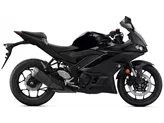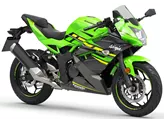Kawasaki Ninja 650 2017 vs. Yamaha YZF-R6 2017

Kawasaki Ninja 650 2017

Yamaha YZF-R6 2017
Overview - Kawasaki Ninja 650 2017 vs Yamaha YZF-R6 2017
The Kawasaki Ninja 650 2017 and the Yamaha YZF-R6 2017 are both supersport motorcycles that offer impressive performance and sleek designs. However, there are several key differences between the two models.
In terms of engine specifications, the Kawasaki Ninja 650 has a larger displacement of 649cc compared to the Yamaha YZF-R6's 599cc engine. The Ninja 650 produces 68.2 horsepower, while the YZF-R6 boasts a more powerful engine with 124 horsepower. Both motorcycles feature DOHC valves and four valves per cylinder, ensuring efficient fuel combustion.
The chassis and frame of the two motorcycles also differ. The Kawasaki Ninja 650 has a steel frame, while the Yamaha YZF-R6 features an aluminum frame. The Ninja 650's tubular frame provides a sporty and agile feel, while the YZF-R6's Deltabox frame offers high transparency and precise handling.

Kawasaki Ninja 650 2017
In terms of suspension, the Ninja 650 has a telescopic fork front suspension, while the YZF-R6 has an upside-down telescopic fork front suspension. Both motorcycles feature double disk brakes at the front, providing strong and direct stopping power.
When it comes to dimensions and weights, the Ninja 650 has a wheelbase of 1410mm, while the YZF-R6 has a slightly shorter wheelbase of 1375mm. The seat height of the Ninja 650 is 790mm, whereas the YZF-R6 has a higher seat height of 850mm. The YZF-R6 also has a larger fuel tank capacity of 17 liters, compared to the Ninja 650's 15-liter capacity.

Yamaha YZF-R6 2017
In terms of strengths, the Ninja 650 offers a transparent chassis for a sporty feel, playful and good-natured handling, excellent brakes, sharp looks reminiscent of the ZX-10R, and a resilient engine. On the other hand, the YZF-R6 boasts strong and direct brakes, sharp looks, an automatic gearshift, good wind protection, precise handling, and high transparency.
However, both motorcycles have their weaknesses. The Ninja 650 lacks sound from the stock exhaust and experiences slight vibrations from the engine. The YZF-R6 has a radical seating position that may not be suitable for touring and comes with standard power of only 118.4 horsepower, which can be costly to upgrade.
In conclusion, the Kawasaki Ninja 650 2017 and the Yamaha YZF-R6 2017 are both impressive supersport motorcycles with their own unique features and strengths. The choice between the two ultimately depends on the rider's preferences and priorities, such as power, handling, and seating position.
Technical Specifications Kawasaki Ninja 650 2017 compared to Yamaha YZF-R6 2017
Pros and Cons in comparison
Pros and Cons in comparison
Kawasaki Ninja 650 2017

The Ninja 650 firmly stamps its predecessor (Er-6f). The engine has mastered the Euro 4 hurdle well and serves up a very usable 68 hp, the chassis is simply great for this class, and the weight reduction of 18(!) kilos compared to the ER-6f justifies reverent nods.
Yamaha YZF-R6 2017

The Yamaha R6 2017 is still a visually and dynamically radical supersport motorbike that is one of the best and probably the last of its kind. The EURO4 standard costs the 599 cubic in-line four-cylinder with titanium valves a whole 11 hp compared to the 2007/2008 model. Yamaha is clearly targeting hobby, amateur and professional racers who don't care about standard performance anyway. With more than 50 accessories, the R6 can be upgraded according to need and budget. However, everyone should be aware that this can cost a lot of money.
Price Comparison Avarage Market Price Kawasaki Ninja 650 vs Yamaha YZF-R6
There are a few key differences between a Kawasaki Ninja 650 2017 and a Yamaha YZF-R6 2017. There are the same number of bikes of both models available on the 1000PS.de marketplace, specifically 7. It takes less time to sell a Kawasaki Ninja 650 with 96 days compared to 136 days for a Yamaha YZF-R6. Since model year 2017 1000PS.de editors have written 20 reviews for the Kawasaki Ninja 650 and 33 reviews for the Yamaha YZF-R6 since model year 2005. The first review for the Kawasaki Ninja 650 was published on 10/4/2016 and now has more than 79,600 views. This compares to more than 3,600 views for the first review on Yamaha YZF-R6 published on 10/17/2002.




















